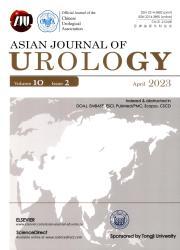尿促性素-II 受体拮抗剂帕洛苏兰对链脲佐菌素诱导的糖尿病大鼠海绵体的影响
IF 2.4
3区 医学
Q2 UROLOGY & NEPHROLOGY
引用次数: 0
摘要
目的探讨尿紧张素受体阻滞剂palosuran对糖尿病大鼠海绵体(CC)分子变化的影响。方法采用帕洛舒兰300 mg/kg / d治疗链脲佐菌素诱导的糖尿病大鼠,连续6周。在器官浴中检测了氯化钾、苯肾上腺素和ng -硝基- l -精氨酸甲酯诱导的CC收缩和电场刺激(EFS)、硝普钠(SNP)(分别为内皮依赖性和内皮非依赖性刺激)和Y-27632 (rho激酶抑制剂)诱导的CC松弛。palosuran和urotensin-II (U-II)诱导的直接收缩或松弛也进行了评估。采用Western blotting或免疫组织化学方法分析一氧化氮合成酶(nos)、RhoA、氧化应激调节因子和U-II的表达水平。结果糖尿病诱导大鼠对SNP的舒张反应减弱,SNP的pD2值降低,Y-27632的舒张反应减弱,CC中RhoA的表达降低,而糖尿病大鼠给予帕洛舒兰治疗后这些参数均逆转;然而,它进一步损害了已经减弱的糖尿病CC对EFS的松弛。虽然诱导糖尿病没有显著改变CC中U-II的表达,但palosuran治疗降低了糖尿病CC中U-II的表达,降低了糖尿病CC中nNOS的表达水平;然而,帕络舒兰治疗未改变神经元NOS表达降低的情况。糖尿病CC条在体外暴露于palosuran产生直接松弛反应。结论palosuran治疗不影响糖尿病CC中NOSs的表达,也不降低EFS刺激引起的氮能传导,但直接引发松弛反应,但未通过降低U-II表达或增加CC对一氧化氮的敏感性引起明显收缩,提示palosuran具有支持勃起功能的潜力。需要进一步和全面的研究来澄清这个问题。本文章由计算机程序翻译,如有差异,请以英文原文为准。
The effects of the urotensin-II receptor antagonist palosuran treatment on the corpora cavernosa of streptozotocin-induced diabetic rats
Objective
This study aimed to investigate the effects of treatment with palosuran, a urotensin receptor blocker, on molecular changes in the corpora cavernosa (CC) in diabetic rats.
Methods
Streptozotocin-induced diabetic rats were treated with palosuran 300 mg/kg per day for 6 weeks. Contraction of CC induced by potassium chloride, phenylephrine, and NG-nitro-L-arginine methyl ester and relaxation of CC induced by electrical field stimulation (EFS) and sodium nitroprusside (SNP) (endothelium-dependent and endothelium-independent stimuli, respectively), and Y-27632 (Rho-kinase inhibitor) were examined in organ baths. Direct contraction or relaxation induced by palosuran and urotensin-II (U-II) were also evaluated. The expression levels of nitric oxide synthetases (NOSs), RhoA, oxidative stress regulators, and U-II were analyzed by Western blotting or immunohistochemistry.
Results
Induction of diabetes in rats resulted in the decreased relaxant response to SNP, decreased pD2 value of SNP, attenuated relaxant response to Y-27632 as well as the decreased RhoA expression in CC. Palosuran treatment of diabetic rats reversed all of these parameters; however, it further impaired the already weakened relaxation of diabetic CC in response to EFS. Although induction of diabetes did not change U-II expression in CC significantly, palosuran treatment reduced U-II expression in diabetic CC. The expression level of nNOS was lowered in diabetic CC; however, palosuran treatment did not change the decreased the neuronal NOS expression. In vitro exposure of diabetic CC strips to palosuran produced a direct relaxant response.
Conclusion
Palosuran treatment did not affect the expression of NOSs or reduce nitrergic conduction induced by EFS stimulation in diabetic CC. However, while directly triggering a relaxant response, it did not induce a prominent contraction either by decreasing U-II expression, or increasing the sensitivity of CC to nitric oxide which suggested that palosuran has the potential to support erectile function. Further and comprehensive studies are required to clarify this issue.
求助全文
通过发布文献求助,成功后即可免费获取论文全文。
去求助
来源期刊

Asian Journal of Urology
UROLOGY & NEPHROLOGY-
CiteScore
4.00
自引率
3.80%
发文量
100
审稿时长
4 weeks
期刊介绍:
Asian Journal of Urology (AJUR), launched in October 2014, is an international peer-reviewed Open Access journal jointly founded by Shanghai Association for Science and Technology (SAST) and Second Military Medical University (SMMU). AJUR aims to build a communication platform for international researchers to effectively share scholarly achievements. It focuses on all specialties of urology both scientifically and clinically, with article types widely covering editorials, opinions, perspectives, reviews and mini-reviews, original articles, cases reports, rapid communications, and letters, etc. Fields of particular interest to the journal including, but not limited to: • Surgical oncology • Endourology • Calculi • Female urology • Erectile dysfunction • Infertility • Pediatric urology • Renal transplantation • Reconstructive surgery • Radiology • Pathology • Neurourology.
 求助内容:
求助内容: 应助结果提醒方式:
应助结果提醒方式:


